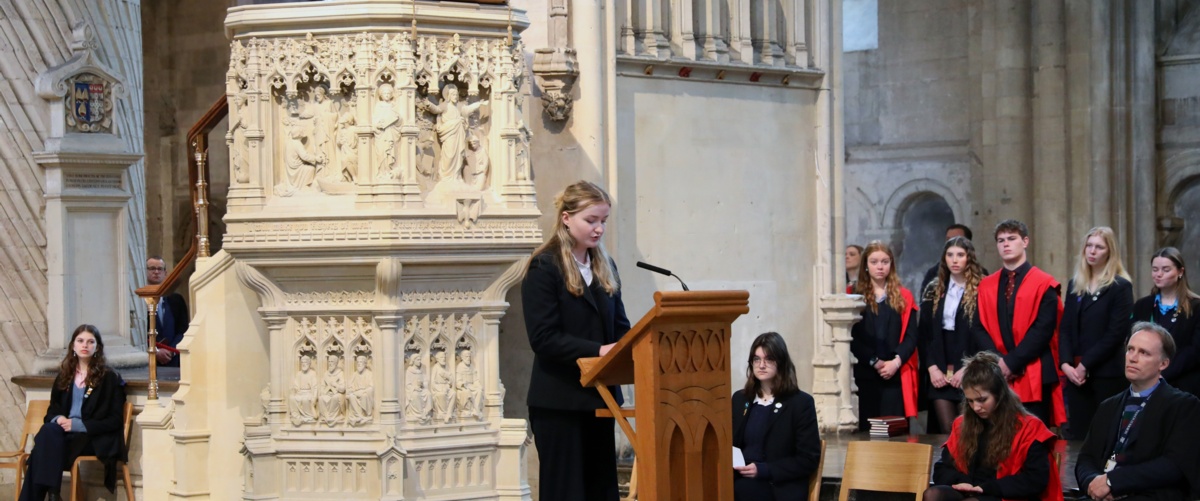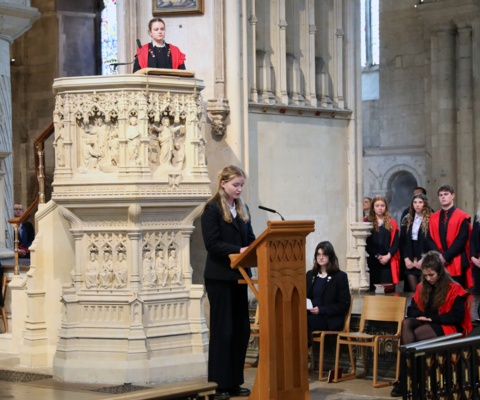To mark International Women's Day, U6 pupil and Red Gown taking the lead for Girls and Young Women, May Maclennan, and fellow pupils Bibi Boyce (U6), Phoebe Burton (L6) and Sophie Hough (L6) spoke about what it means to be inspirational...
May:
Today is International Women’s Day, and ever since it was first celebrated in 1911, it has been used as a time to lift up inspirational female figures. However, in recent years, some would say that feminism has too often slipped into a feel-good inspiration ideology. This is the viewpoint presented by Helen Lewis in her first book, ‘Difficult Women’. It made a lot of sense to me as I began to realise the pressure women are under to be the perfect woman or the perfect feminist. The impact of presenting inspirational figures with stories filtered of all flaws gives us the sense that we cannot be anything short of perfect to be worthy of making a difference.
If we take a look at the suffragette movement of the early 20th century, one of the first names that might pop into your head is Emeline Pankhurst, well known for the unprecedented work she did in revolutionising women’s rights that we can still be thankful for today. What is less known is that she also had a reputation of being terrifying to work under due to her determination and rigour. Eliminating this part of her story would be to follow the patriarchal stereotype that women maintained perfection even in pursuit of great societal change. Instead, we must ask ourselves, would they have achieved what they did without her? Absolutely not. Such achievements require a ferocious and rebellious nature.
Feminism is not a story of horrendous men being awful to lovely, misunderstood women. Women have long been fighters, have long been difficult, have long made mistakes but have reached important milestones nonetheless. Today, members from femsoc would like to tell you about some of the female figures who have inspired them in all their messy, persistent and beautiful glory.
Phoebe:
On this year’s International Women’s Day, I would like to talk about my aunt, Catherine, who was in the police force for 30 years, and now trains new recruits entering the force. In 1989, the year she joined the police, she was the only female police constable on her shift of 12 male officers. At that time, women had to wear skirts as a part of their police uniform and had to be a minimum of 5 feet 4 inches. Now, she trains new recruits, of which at least 50% are women, and both the uniform and height restrictions have been discarded.
In 1992 she was trained in dealing with sexual offences, and it was common that women in the police force would only deal with the women and child victims, rather than allowing the victim to choose who they would rather talk to, whether it be a man or a woman. After 25 years of service as a PC, she was promoted to detective sergeant in 2014. Throughout her service, she saw more senior ranks being filled by women, but still feels that the women she trains work twice as hard for half the recognition, just as she did back in 1989. Despite older male colleagues often mocking her, Catherine has never stopped calling out unacceptable behaviour within the workplace, particularly towards women – one incident being a male recruit continuously referring to female peers as “it”, which occurred only in the past year.
After finishing her role as a recruit trainer, Catherine will now go on to be an individual sexual violence advisor, or ISVA. This involves her communicating with people in hard-to-reach groups who may have been victims of sexual violence, and support victims in the court process. It is shown that victims are 56% more likely to support a prosecution when supported by an ISVA.
Today, women from all backgrounds make up half of the police force, a world away from the 1 in 12 that my aunt was a part of, creating a more accessible police force to the wider community as it becomes more diverse. The job has gradually become more adapted to women, allowing them to work in all aspects of the force, and even investing in body armour that fits the shape of a woman’s body. Catherine has always been resilient and stood up for what she believes in, even if she is in the minority and occasionally made fun of by her male colleagues, and although her workplace has become a lot more accessible over the years, there is still a long way to go to achieve parity.
Bibi:
Henrietta Swan Leavitt is a name that I'm certain that very few of you will know, but she was instrumental in developing our modern-day perception of the universe. She was employed as a ‘human computer’ at Harvard University’s observatory in the very early 20th century, logging the brightness and position of stars in the sky. Women were often employed in this sort of role as they were much cheaper labour, and this was seen as menial work that was beneath the male scientists. However, through her work, Leavitt noticed and established a relationship between the luminosity and the period of Cepheid variables - a class of giant yellow stars that expand and contract regularly, and their brightness therefore changing periodically, which can be observed.
As she was studying all the stars in the Small Magellanic Cloud, she was able to assume that they were roughly the same distance, and through this relationship she could calculate the distance. Previously, astronomers had only been able to measure up to several hundred light years, but using Leavitt’s work they could now measure up to 20 million light years. At this point in time, it was still believed that the milky way was the whole universe - but now, astronomers know that the universe is in fact much larger. After Leavitt’s death, Edwin Hubble used the relationship to establish that the universe is expanding. Both discoveries have completely shaped our understanding of the universe, including the theorisation of the Big Bang. We owe this to the discoveries of Henrietta Swan Leavitt despite the overwhelming barriers she would have faced as a woman, as well as a deaf person.
Sophie:
On this International Women’s Day, I thought I would talk about Jocelyn Bell Burnell. If you are interested in astrophysics, you may have heard of her as she made some important discoveries in radio astronomy.
Born in Northern Ireland in 1943, she became interested in astronomy from a young age, but her school only allowed girls to study sciences after her parents, along with others, campaigned to change the school’s policies. However, she failed the eleven-plus exam that would allow her entry to a grammar school, and was sent instead to a Quaker girls’ boarding school in England.
After graduating from the University of Glasgow with a degree in physics, where she had been the only woman in a class of fifty, she went on to study for a PhD at the University of Cambridge. It was during this period that she worked with her thesis supervisor, Anthony Hewish, among others, to construct a radio telescope just outside Cambridge. The purpose of this was to study quasars — very luminous astronomical objects found in the centres of some galaxies, that spiral into supermassive black holes.
Bell Burnell spent hours analysing the data from her experiments to monitor quasars, and, on the 28th November 1967, discovered what she called a “bit of scruff” on her chart-recorder papers. She ascertained that this strange signal was pulsing at a regular rate, with one pulse every four thirds of a second, and consulted Hewish. He thought she had simply wired the telescope up wrongly, but she persisted in her examining the data, and soon discovered many other regular patterns of radio waves. Over the following months, the team eliminated possible sources of the pulses — which they jokingly named “Little Green Men,” for the unlikely possibility that the pulses came from extra-terrestrial life trying to communicate. They later determined that they were coming from rapidly spinning neutron stars, very dense stars thought to be composed mostly of neutrons, and were dubbed pulsars by the press.
In 1974, the Nobel Prize for Physics was awarded for the discovery of pulsars. It did not go to Jocelyn Bell Burnell, despite her being the one who originally pointed out the anomaly. Instead, her thesis supervisor, Hewish, and another man named Martin Ryle, took the prize, but she still went on to have a successful career in astrophysics, including being made president of both the Royal Astronomical Society and the Institute of Physics.
To me, Jocelyn Bell Burnell is an incredibly inspirational female figure, as she was an ordinary student who discovered an extraordinary thing.
May:
Phoebe’s aunt Catherine, Henrietta Swan Leavitt, Jocelyn Bell Burnell and Emeline Pankhurst are just a few examples of women who did not shy away from being perceived as ‘difficult’ to pursue what they truly believed in. The corporatisation of feminism has meant the women who have achieved incredible things are distilled down into those achievements alone, not accepting the bigger picture of what they did to get there. Thinking critically about people’s possible faults alongside their clear successes can promote the idea that you don’t need to be under the immense pressure of being perfect to achieve your goals. We don’t have to be golden to change the world; difficult women are the ones who make history. Thank you for listening.


